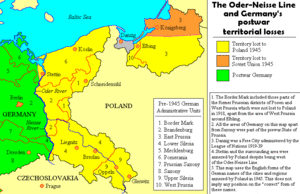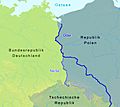Oder-Neisse line facts for kids
The Oder-Neisse line is a very important border between Germany and Poland. It was created after World War II ended. This border is named after two rivers: the Oder and the Neisse. It marked a big change in the map of Europe.
Contents
The Oder-Neisse Line: Germany's Post-War Border
The Oder-Neisse line became the official boundary between Germany and Poland after Germany was defeated in World War II. This new border meant Germany lost a large part of its land to Poland. This was not the first time Germany's borders changed. After World War I in 1919, Germany also gave up parts of its territory, like the provinces of Posen and Westpreußen, to the new country of Poland.
How the Border Changed
The new border along the Oder and Neisse rivers was a major outcome of World War II. It moved Poland's western border much further to the west. This change was decided by the winning countries of the war. It aimed to reshape the map of Europe and create new political realities after the conflict.
People Moving Homes
When the Oder-Neisse line became the new border, many people had to move. About 12 million Germans lived in the eastern provinces of Germany and in parts of Poland before the war. Many of these people either fled their homes as the Russian army advanced, or they were later forced to leave by Polish groups.
As Poland took over these former German areas, Polish people moved into them. Many of these new inhabitants had also been forced from their homes. They came from eastern Poland, which was taken over by the U.S.S.R. in 1939. This meant that millions of people on both sides had to leave their homes and start new lives elsewhere.
Images for kids
-
Oder Lagoon area with border on western bank of the Oder, city of Szczecin to the south.
-
US Department of State Demographics map from 10 January 1945 Germany – Poland Proposed Territorial Changes, based in part on German prewar population census. Was used for border discussions at the Potsdam Conference later in 1945.
-
1951 East German stamp commemorative of the Treaty of Zgorzelec establishing the Oder–Neisse line as a "border of peace", featuring the presidents Wilhelm Pieck (GDR) and Bolesław Bierut (Poland)
-
The Lusatian Neisse dividing German Görlitz (right) from Polish Zgorzelec (left); formerly both constituted the city of Görlitz.
See also
 In Spanish: Línea Óder-Neisse para niños
In Spanish: Línea Óder-Neisse para niños














